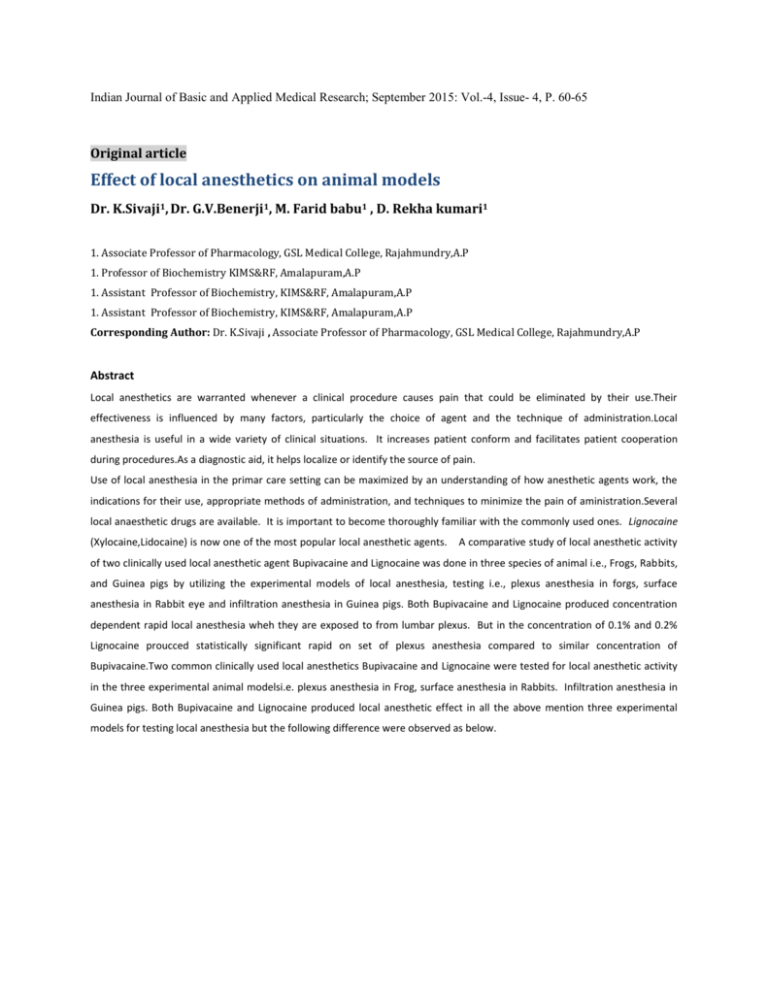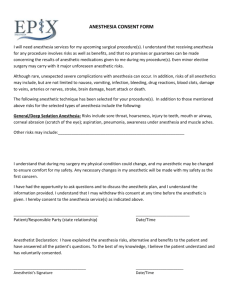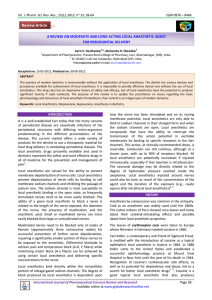Effect of local anesthetics on animal models
advertisement

Indian Journal of Basic and Applied Medical Research; September 2015: Vol.-4, Issue- 4, P. 60-65 Original article Effect of local anesthetics on animal models Dr. K.Sivaji1, Dr. G.V.Benerji1, M. Farid babu1 , D. Rekha kumari1 1. Associate Professor of Pharmacology, GSL Medical College, Rajahmundry,A.P 1. Professor of Biochemistry KIMS&RF, Amalapuram,A.P 1. Assistant Professor of Biochemistry, KIMS&RF, Amalapuram,A.P 1. Assistant Professor of Biochemistry, KIMS&RF, Amalapuram,A.P Corresponding Author: Dr. K.Sivaji , Associate Professor of Pharmacology, GSL Medical College, Rajahmundry,A.P Abstract Local anesthetics are warranted whenever a clinical procedure causes pain that could be eliminated by their use.Their effectiveness is influenced by many factors, particularly the choice of agent and the technique of administration.Local anesthesia is useful in a wide variety of clinical situations. It increases patient conform and facilitates patient cooperation during procedures.As a diagnostic aid, it helps localize or identify the source of pain. Use of local anesthesia in the primar care setting can be maximized by an understanding of how anesthetic agents work, the indications for their use, appropriate methods of administration, and techniques to minimize the pain of aministration.Several local anaesthetic drugs are available. It is important to become thoroughly familiar with the commonly used ones. Lignocaine (Xylocaine,Lidocaine) is now one of the most popular local anesthetic agents. A comparative study of local anesthetic activity of two clinically used local anesthetic agent Bupivacaine and Lignocaine was done in three species of animal i.e., Frogs, Rabbits, and Guinea pigs by utilizing the experimental models of local anesthesia, testing i.e., plexus anesthesia in forgs, surface anesthesia in Rabbit eye and infiltration anesthesia in Guinea pigs. Both Bupivacaine and Lignocaine produced concentration dependent rapid local anesthesia wheh they are exposed to from lumbar plexus. But in the concentration of 0.1% and 0.2% Lignocaine proucced statistically significant rapid on set of plexus anesthesia compared to similar concentration of Bupivacaine.Two common clinically used local anesthetics Bupivacaine and Lignocaine were tested for local anesthetic activity in the three experimental animal modelsi.e. plexus anesthesia in Frog, surface anesthesia in Rabbits. Infiltration anesthesia in Guinea pigs. Both Bupivacaine and Lignocaine produced local anesthetic effect in all the above mention three experimental models for testing local anesthesia but the following difference were observed as below.








